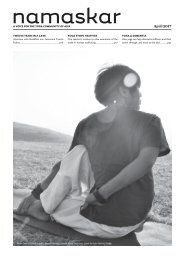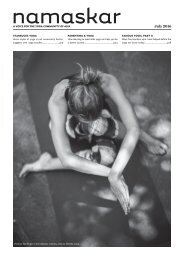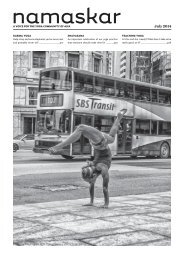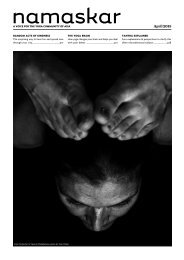Create successful ePaper yourself
Turn your PDF publications into a flip-book with our unique Google optimized e-Paper software.
the point above the<br />
crescent moon<br />
represents pure<br />
consciousness<br />
Unlike all other sounds, which require air<br />
movement to create their sound, in the case<br />
of Aum the fourth syllable is silent, the<br />
unstruck sound (anahat nada), and we shall<br />
come back to this when we examine how<br />
to chant Aum.<br />
The pictograph of Aum, which is familiar<br />
to most yogis (and anyone who happens<br />
to have seen the tattoo on my back) also<br />
symbolizes different aspects of our<br />
consciousness a) the waking state : jagrathaavastha<br />
“A”, b) the subconscious dream<br />
state: svapna-avastha “U” and c) the<br />
unconscious state: susupta-avastha “M’ and<br />
these states are represented by the three<br />
curves that combined look a bit like the<br />
number 30.<br />
Now for the really interesting bit - the<br />
point (bindu – which in metaphysics<br />
represents the point where multiplicity<br />
merges back into unity) above the crescent<br />
moon represents the unstruck sound I<br />
referred to earlier in this article. It represents<br />
the fourth state of consciousness called<br />
Turiya which is pure consciousness and<br />
transcends the other three states. In Turiya<br />
there are no thoughts and no “I” and no<br />
relative existence.<br />
The crescent moon below the bindu<br />
represents maya, (which in Vedanta is the<br />
illusion of the ‘reality’ of the manifest and<br />
in Tantra is the veil that cloaks the absolute<br />
from the relative). But let’s move on to<br />
consider how to chant.<br />
HOW TO CHANT AUM<br />
So once we are sitting comfortably we can<br />
commence our Aum japa. The first syllable<br />
is the “A” and is pronounced as ‘ahhh’<br />
somewhat like the sound made when the<br />
doctor wishes to inspect your tonsils! It<br />
should come from the back of the throat<br />
with the lips in a quite wide horizontal<br />
elliptical shape akin to a wide-mouthed<br />
frog (if you ever happen to have spotted<br />
one)! It refers to the gross world i.e. the<br />
physical world.<br />
Then comes the “U” as the second syllable<br />
and is pronounced somewhere between an<br />
‘oo’ and an ‘or’ with the lips closing slightly<br />
into an oval shape and resembles the<br />
sound you might make if the doctor then<br />
took your temperature using a very cold<br />
rectoral thermometer! It refers to the subtle<br />
astral world.<br />
Then comes the third syllable, the “M”,<br />
pronounced ‘mmm’ with the lips gently<br />
closed (which intensifies the vibratory<br />
resonance in the brain per Sri Dharma<br />
Mittra, whom many readers will know as a<br />
remarkable teacher of yoga with over half a<br />
century of experience). The sound is similar<br />
to that made after your first sip of hot<br />
coffee on a cold winter’s day. It refers to the<br />
causal realm and can be imagined as the<br />
canvas on which the subtle and gross<br />
realms are painted.<br />
Finally, last but by no means least, we arrive<br />
at the fourth syllable referred to earlier,<br />
which is the unstruck sound of silence,<br />
which does not sound like any other sound<br />
in the manifest world, wherein the<br />
practitioner may experience absolute reality<br />
which encompasses all three of the prior<br />
realms above. This last realm is the most<br />
esoteric and probably the one most<br />
students will take time to fully appreciate,<br />
but during the silence the practitioner can<br />
still experience the vibration of the mantra<br />
in the higher chakras, particularly in ajna<br />
(third eye) and sahasrara (crown) chakras.<br />
RATIOS<br />
There does not appear to be any scriptural<br />
text that defines the ratio of time of each<br />
syllable of the mantra, but typically most<br />
gurus and swamis (e.g. Swami Jnaneshvara<br />
Bharati), who have commented on this<br />
topic, suggest the “M” should be longer<br />
than the “A” and “U” but to varying<br />
degrees. Personally I think after practicing<br />
for a while, one develops a sense of what<br />
feels right for you, although in a class<br />
situation it is respectful to follow the lead<br />
of the teacher. Typically beginners with<br />
limited lung capacity may find their “M” is<br />
too short because they run out of breath,<br />
so unless you are an ex-deep sea pearl diver<br />
then try not to get carried away with the<br />
“AU” parts.<br />
DECIBELS<br />
So is there any guidance on how loud the<br />
Aum should be? Again, different traditions<br />
seem to have different approaches from<br />
soft to loud. In Sanskrit the word japa<br />
(repetition) derives from the root ‘jap’<br />
which means ‘to utter in a low voice, repeat<br />
internally or mutter’, so that would suggest<br />
a softer Aum is appropriate. However, a<br />
louder chant can be invigorating and (per<br />
Omved) gives the practitioner a sense of<br />
the omnipotence of the Supreme. I would<br />
also add that chanting silently does not give<br />
me the physical experience of feeling the<br />
vibration of the sounds, not to mention in<br />
a group setting it would seem a bit solitary!<br />
So the only conclusion I can draw on this<br />
point is that the fourth syllable, the<br />
unstruck sound, should be silent, no<br />
matter which tradition you follow.<br />
FINAL FOOD FOR THOUGHT:<br />
In the Bhagavad Gita, Krishna highlights<br />
the importance of chanting Aum at the<br />
time of one’s death: “Repeating in this<br />
state (of meditation) the divine name, the<br />
syllable Om that represents the changeless<br />
Brahman, you will go forth from the body<br />
and attain the supreme goal.” (Ch 8.13)<br />
But for those of you in more of a hurry to<br />
reach samadhi, I should like to refer you to<br />
the Shiva Purana which apparently states<br />
1,080,000,000 recitations of Aum purify<br />
our mind and lead us automatically to<br />
salvation. By my calculations, assuming 30<br />
seconds per Aum, if you chant 12 hours a<br />
day uninterruptedly for just over 2,000<br />
years you will have reached the requisite<br />
number of recitations!<br />
Off I go….1,2,3….oh darn, there goes my<br />
Blackberry again!<br />
Andy is an<br />
enthusiastic yoga<br />
practitioner and now<br />
teacher too with a<br />
background in<br />
aerobics and martial<br />
arts. Outside work as<br />
a headhunter and<br />
practising yoga, he<br />
plays the saxophone<br />
for pleasure...his,<br />
rather than the<br />
neighbours’!<br />
19

















